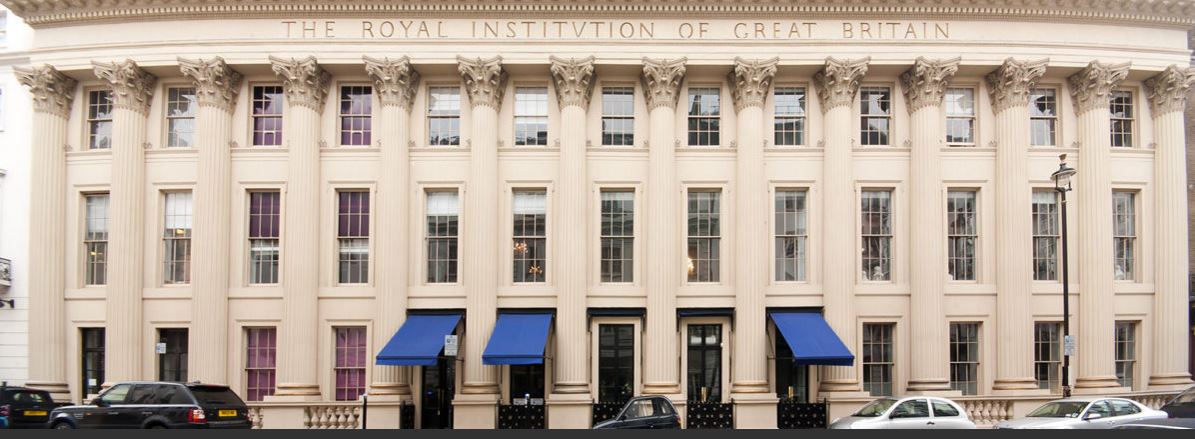There is an auction sale taking place this first day of December that is notable for more than the material offered, though it is certainly special. It is its source that is notable, a source of some controversy, though not nearly what it once would have caused. Institutional deaccessioning, once dependably controversial, is less so today. Reality sets in.
The Royal Institution, for over 200 years a supporter of scientific research and a repository of its findings, has found itself in some financial difficulties over the past decade. The Institution undertook some significant projects in its Mayfair (London) building during the first decade of this century. It's an enormous building that has been around since the group's founding in 1799, so some upgrades are occasionally necessary. It was an expensive project, leaving the Institution with more debt than it could handle. The result was it had to seriously consider selling its building a few years ago.
Fortunately, the Royal Institution's home was saved by an anonymous gift of £4.4 million. However, that still leaves it with £2 million needing to be repaid. The trustees reached the conclusion that the best way to handle the remaining debt load would be to sell some of the books in its collection. Additionally, they will be making some space in their building available for rent to bring in additional income. The trustees selected 85 items from their collection, which they described as "non-core heritage items." The material is estimated to be worth £750,000 (approximately $1,150,000).
The highlight is a copy of Vesalius' De humani corporis fabrica libri septem. Published in 1543, it has been called "the most famous anatomical work ever published,...and the milestone in all medical history." Vesalius reached his conclusions based on dissecting the human body. That may sound obvious today, but was a radical idea at the time. Galen, then the authority, made his observations by dissecting the bodies of animals. This book is estimated to sell for £140,000 - £220,000 ($214,760 - $337,480). It also explains what is "non-core" for the Royal Institution. It has specific, extensive collections, most notably that of Michael Faraday. Faraday was the 19th century physicist who conducted all sorts of experiments with electricity. He did much of his work at the Royal Institution. Recently, the Institution purchased 30 Faraday letters to add to its collection.
Some scientists raised objections. Sir Andre Geim, winner of the Nobel prize for physics, was reported to have said the Royal Institution should reconsider a suggestion made a couple of years earlier to merge with the Royal Society instead. However, for the most part, the reaction seems to have been subdued. A few years ago, the idea of selling off significant books from an institutional collection likely would have generated widespread outrage. Today, there is greater understanding that sometimes practical financial concerns must trump preserving every last item within such a collection.
The Royal Institution explained its decision in a statement from its Chairman, saying, "The Ri is committed to preserving and promoting our unique scientific legacy. We believe that taking these necessary steps will provide a strong foundation from which to safeguard our core heritage collection - the Faraday Museum and Archive Collection - and continue our vital work across all of our charitable programmes for the benefit of future generations."
From a collecting standpoint, this is not the worst of news. Certainly, there is disappointment in seeing public-spirited if not publicly owned institutions dispersing cultural icons. For so many years, institutions have built up and preserved great collections of historical material. However, in so doing, they have made some of the best items virtually unavailable to private collectors, while driving up the prices of the few examples that are left in circulation. Making the finest material extremely expensive if not unobtainable is not the best way to encourage collecting. Perhaps there are worse things that can happen to historic works than to see a few examples come out of rarely used institutional collections and into the hands of collectors who will truly cherish having them for some brief period of time, and then turning them over to the next generation of collectors to share in that experience.





![<b>Forum, July 17:</b> Henry VII (King) & Philip the Fair (Duke of Burgundy). [Intercursus Magnus], [Commercial and Political Treaty between Henry VII and Philip Duke of Burgundy], manuscript copy in Latin, original vellum, 1499. £8,000 to £12,000. Forum, July 17: Henry VII (King) & Philip the Fair (Duke of Burgundy). [Intercursus Magnus], [Commercial and Political Treaty between Henry VII and Philip Duke of Burgundy], manuscript copy in Latin, original vellum, 1499. £8,000 to £12,000.](https://ae-files.s3.amazonaws.com/AdvertisementPhotos/148a7ca4-9746-44c9-a75e-86229b6f10d2.png)






![<b>Forum, July 17:</b> Sowerby (George Brettingham). Album comprising 22 leaves of original watercolour drawings of fossil remains of Cheltenham and Vicinity, [c.1840]. £6,000 to £8,000. Forum, July 17: Sowerby (George Brettingham). Album comprising 22 leaves of original watercolour drawings of fossil remains of Cheltenham and Vicinity, [c.1840]. £6,000 to £8,000.](https://ae-files.s3.amazonaws.com/AdvertisementPhotos/863855a8-4b41-4512-b168-a4a3eab5d6a6.png)




![<b>Sotheby’s, Ending July 10:</b> John Gould. <i>The Birds of Europe,</i> [1832-] 1837, 5 volumes, contemporary half morocco, subscriber’s copy. £40,000 to £60,000. Sotheby’s, Ending July 10: John Gould. The Birds of Europe, [1832-] 1837, 5 volumes, contemporary half morocco, subscriber’s copy. £40,000 to £60,000.](https://ae-files.s3.amazonaws.com/AdvertisementPhotos/64dbb393-4712-4536-a1a6-26d823c523dc.png)








![<b>DOYLE, July 23:</b> [AUTOGRAPH - US PRESIDENT]FRANKLIN D. ROOSEVELT. A signed photograph of Franklin D. Roosevelt. Estimate $500-800 DOYLE, July 23: [AUTOGRAPH - US PRESIDENT]FRANKLIN D. ROOSEVELT. A signed photograph of Franklin D. Roosevelt. Estimate $500-800](https://ae-files.s3.amazonaws.com/AdvertisementPhotos/4ce5fa1d-1943-4413-a80d-7b5c75383e7e.jpg)
![<b>DOYLE, July 23:</b> [ARION PRESS]. ABBOTT, EDWIN A. <i>Flatland. A Romance of Many Dimensions.</i> San Francisco, 1980. Estimate $2,000-3,000. DOYLE, July 23: [ARION PRESS]. ABBOTT, EDWIN A. Flatland. A Romance of Many Dimensions. San Francisco, 1980. Estimate $2,000-3,000.](https://ae-files.s3.amazonaws.com/AdvertisementPhotos/fa635c85-6b12-44f2-8832-2087579574d9.jpg)
![<b>DOYLE, July 23:</b> TOLSTOY, LYOF N. and NATHAN HASKELL DOLE, translator. <i>Anna Karénina ... in eight parts.</i> New York: Thomas Y. Crowell & Co., [1886]. Estimate: $400-600 DOYLE, July 23: TOLSTOY, LYOF N. and NATHAN HASKELL DOLE, translator. Anna Karénina ... in eight parts. New York: Thomas Y. Crowell & Co., [1886]. Estimate: $400-600](https://ae-files.s3.amazonaws.com/AdvertisementPhotos/af9f4e1a-90c2-428c-8d49-9624b070c7a9.jpg)









